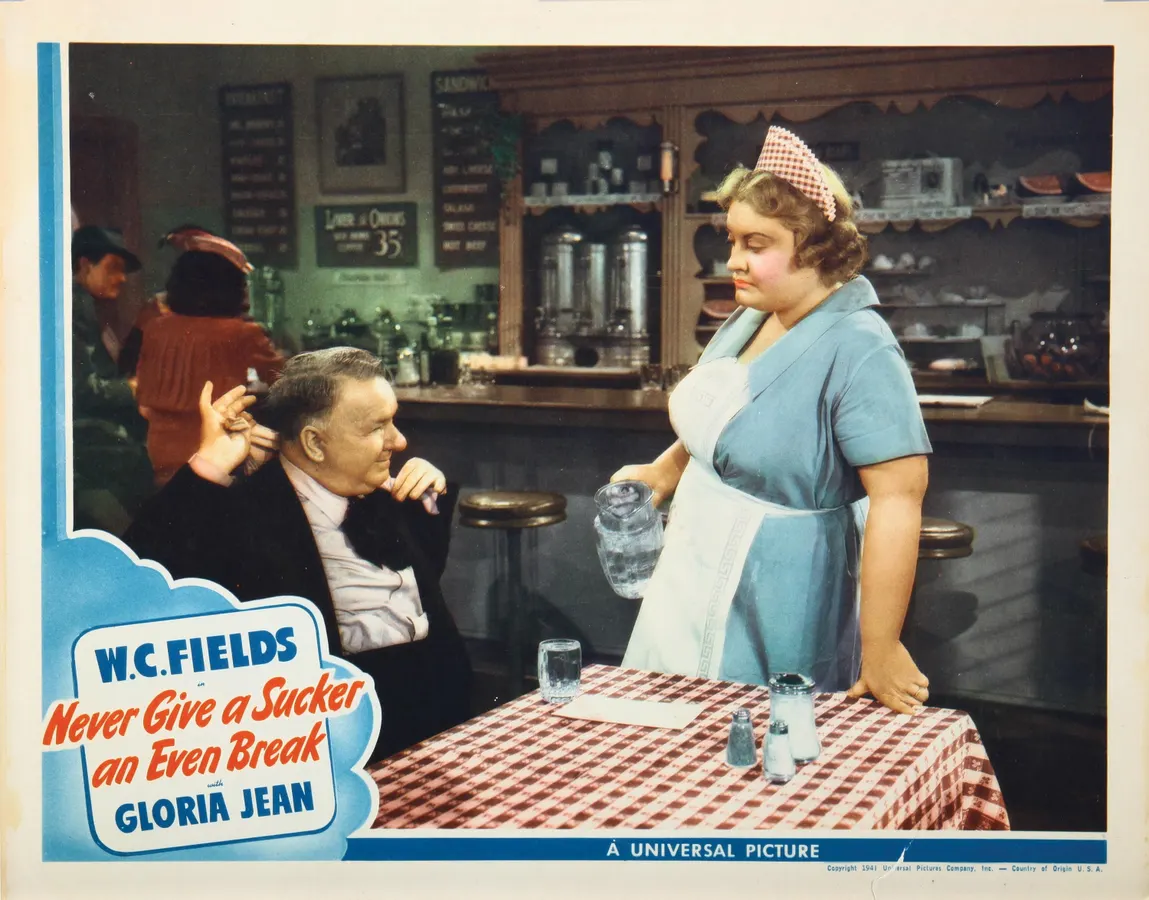By Contributor,John Mariani
Copyright forbes

Never Give A Sucker An Even Break, US lobbycard, from left: W.C. Fields, Jody Gilbert, 1941. (Photo by LMPC via Getty Images)
LMPC via Getty Images
For better or worse, stereotypes often do have a basis in real life, like the bewilderment as to why you can’t get a decent bagel outside of New York or a good gumbo outside of Louisiana.
When it comes to people and national stereotypes, the slope becomes slippery, unless the stereotype happens to be one enjoyed by a particular segment of society, like rocket scientists and brain surgeons.
There are, however, such things as national traits, even if they vary by region––Texas leaps to mind––so when making comparisons between American and French restaurant waiters I admit that there are some on both continents who epitomize the highest standards and others who are totally inept at their jobs.
An unidentified waiter discusses the menu with diners at a table in the dining room at the French restaurant La Grenouille, New York, New York, March 1978. (Photo by Susan Wood/Getty Images)
Getty Images
Let’s start there, with jobs: In the U.S. a waiter is more often than not just doing a job––the stereotype of the aspiring actor who waits tables, which includes Jennifer Aniston, Sandra Bullock, Lady Gaga and Madonna is absolutely true. (It’ s interesting that a Google search for French actors who were waiters turns up just one name: Alain Délon.) In France (and most of Europe) being a waiter is considered a profession, and it is one that is based not on tips, which are minimal, but on a good salary with benefits. France does have a 35-hour work week (known as the Loi Aubry) but waiters may choose to work overtime. Minimum wage is between €8.43 and €11 per hour, or €1,300 to €1,750 per month––the average French person makes €1,000––but that includes health insurance, retirement and other benefits, which would be a rarity in a U.S. restaurant, where the federal minimum wage is $2.13 and the average income for a waiter is about $35,000 a year, based on an hourly $17.70, including tips.
TOPSHOT – French waiter and bartender Camille poses in front of the iconic cafe and restaurant, opened in 1884, “Les Deux Magots” in Paris’ 6th district, on April 17, 2024. From the stage of the Moulin Rouge to the tarmac of Charles-de-Gaulle airport and the Chateau de Versailles, AFP photographers went to meet the French people who will be welcoming the millions of visitors to the Paris 2024 Olympic Games. They are police officers, bus drivers, museum attendants or waiters, and this summer they will be in contact with the more than 15 million tourists expected in the capital. Rarely in the limelight, these men and women embody the diversity of people and professions that make up the Parisian postcard. Search for all these reportage images using: FRANCE-OLY-PARIS-2024-PARIS WELCOMES YOU (Photo by MIGUEL MEDINA / AFP) (Photo by MIGUEL MEDINA/AFP via Getty Images)
AFP via Getty Images
MORE FOR YOU
In large cities like New York, DC, Houston and Chicago, however, a waiter at a higher-end restaurant where the cost of a meal can run over $100 per person can easily make $70,000 to $100,000 a year, which would be highly unlikely in France. Nevertheless, except for long-time waiters who have committed to the job as a profession, waitering is for most Americans a first job or a way-stop until something better comes along. For that reason, many who take the job are not well trained or even all that interested in the rules, niceties and nuances of a job that takes skill, stamina, psychology and a sure degree of stifling anger. Rudeness and insults by customers are frequent, sexual harassment always lurking, and the threat of losing a good tip can deflate even the bubbliest of personalities.
These abuses happen in France, too, but to a lesser extent because European customers have more of a rapport with their waiters and a respect for their profession. The stereotype of the snooty mustachioed French waiter owes more to Hollywood comedies than reality, but many Americans abroad bristle if a waiter doesn’t speak or understand English or bridle at one who seems icy, rather than an American waiter who pretends to be your pal. You never hear French waiters announcing their names or saying, “That dish is one of my favorites!” or “You guys still working on that?”
LOS ANGELES – JANUARY 1: ALICE, cast members (from left) Polly Holliday (as Flo, Florence Jean Castleberry), Linda Lavin (as Alice Hyatt) and Beth Howland (as Vera Louise Gorman). January 1, 1979. (Photo by CBS via Getty Images)
CBS via Getty Images
The stereotype of the “sassy” American waitress is just as much a stage character as a reality, and some restaurants even have a winking pride having staff who can playfully insult a customer aware of the game. Remember the waitress Flo “Kiss My Grits” Castleberry in the 1970s sitcom Alice and Max Black on 2 Broke Girls?
French waiters are well trained to perform many tableside tasks that would stymie American counterparts, such as deboning a whole fish, cutting a roast chicken or flaming a dessert. They also don’t wear silly outfits.
Hooters waitresses await customers at the opening of the US restaurant chain’s first outlet in Beijing, 10 September 2007, and fourth overall in China. Hooters offers it customers a taste of the US with its signature combination of cold beer, chicken wings and waitresses in clingy shirts and orange high-cut shorts. AFP PHOTO/Frederic J. BROWN (Photo credit should read FREDERIC J. BROWN/AFP via Getty Images)
AFP via Getty Images
Then there is the question of the hours worked: in France it is rare that guests arrive before one PM for lunch (two PM in Spain) and eight for dinner. But they may also arrive as late as ten or ten-thirty (in Greece that would be early). So the work hours extend from seven (for prep) to eleven or midnight in France. In the U.S., lunch might begin at 11 AM and dinner at 5 PM––Early Bird Dinners are appalling to the French–––and trail off by 9:15. Nevertheless, I’ve found it all too often the case that around nine o’clock American waiters simply disappear like frightened birds from the dining room, seemingly to take a break or to make phone calls, whatever. In France I have never found that to be the case, because by nine o’clock service is in full swing and keeps going full tilt past eleven.
I have always believed that if I owned a restaurant I’d post a sign in the kitchen saying, “If you’re not ordering or picking up food, get out of this kitchen!”
19th May 1981: The world’s worst waiter, Manuel from TV’s ‘Fawlty Towers’, played by actor Andrew Sachs, demonstrates how much he needs to heed the advice contained in the new ‘Tea Pack’ training manual for caterers. (Photo by Keystone/Getty Images)
Getty Images
Being a waiter is hard work––and I’ve done it––but in the U.S. it slows down after nine o’clock, when the busboys kick into high gear to clear plates. By then waiters have finished taking orders for the night. Outside of big cities, many restaurants empty out by nine. In Los Angeles movie people are famous for heading home by nine to be on the movie set by six the following morning. In fact, most American cities are not late-night towns.
All things considered, I’d rather have a knowledgeable, attentive waiter with a professional demeanor than one who is overly chummy, interruptive and often gone from the dining room. I’ve had many of both and all kinds in between, which is the best of both world. I wish everyone should have the same.
Editorial StandardsReprints & Permissions



